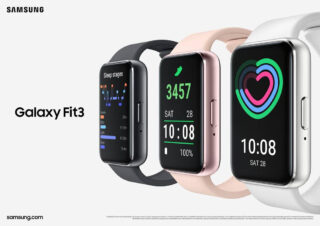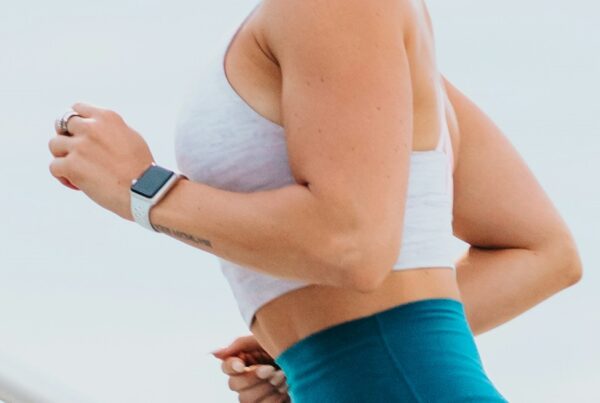Technology has become an integral part of my fitness journey. I can’t imagine enjoying a meal or taking a walk without recording my calorie intake or tracking my steps. It seems that I’m not the only one that feels this way, with the global fitness tracker market expected to be worth a whooping US$74.61bn by the end of the year. The market has evidently become saturated with fitness trackers, so how do you pick the best one for yourself? To help you make the decision, I recently had the opportunity to try out the Samsung Galaxy Fit3 and find out if it helps you work harder and smarter.
Samsung Galaxy Fit3: Train Harder & Smarter
Samsung’s latest release, the Galaxy Fit3, offers a wearable tracker that serves to go beyond just monitoring your steps. With an aluminum body and 1.6-inch display, which made it incredibly easy for me to check my health stats at a glance, the newest fitness tracker also offers a lightweight, sleek and comfortable fit – I sometimes forget that I’m even wearing it.
The look and feel
With the world going fully digital, it can be incredibly frustrating to have to watch a lagging screen. Thankfully, this is not an issue you’ll come across with Samsung’s latest offering. On a swipe or tap, you can effortlessly navigate through the Galaxy Fit3 without having to deal with lagging or stuttering, and the lift to wake is responsive. I do appreciate how fluid navigation on the watch is, especially because there were a few instances where I had to dig quite deep to find settings that needed to be changed.
In terms of personalization, the Galaxy Fit3 allows you to select from over 100 presets, and I made sure to pick a watch face that was indicative of my drive to improve my health. If you’re not a fan of any of the offered themes, you can select a photo from your phone’s albums and use it as the background. Also, if you’re hoping for your watch to match your gym gear, you can mix and match bands by simply clicking a button and choosing a band that complements your colour scheme for the day.
Delving beyond aesthetics, Samsung alleges that their watch’s long battery life can last up to 13 days – which I found to be false, at least with my device. Perhaps the 13-day battery life is limited to individuals who aren’t routinely checking their watches and making use of the offerings, as I was. If so, you can expect about 3 days of battery life.
Track every workout
In addition to letting me know when I’ve been spending too much time sitting, which can increase your risk for a number of chronic conditions, the Galaxy Fit3 offered me to track over 100 types of workouts, beyond the typical dancing, walking and yoga, such as alpine skiing, arm curls, backpacking, burpees, hula-hooping, roller skating, star jumps, and even yachting. Sadly, there is no GPS on the watch. So while the watch does connect via Bluetooth to your phone’s GPS, that means you’ll need to take your phone with you on every outdoor workout excursion – which may not sound appealing to everyone.

Samsung Galaxy Fit3
The watch’s sensors are quite sensitive, so much so that it picks up a quick 5 minute walk as a workout. Additionally, Samsung has worked to ensure that you are assisted should you hurt yourself during your workouts, as the watch offers hard fall detection and Emergency SOS, providing the chance for you to reach out to emergency services by simply pressing the side button five times.
Importance of sleep
I may follow a healthy diet and regularly exercise, but both of these tasks would prove to be futile if I’m not getting enough sleep – and Samsung agrees. As such, the Galaxy Fit3 offers sleep monitoring tools aimed at understanding and improving your sleep habits. Wearing my Samsung tracker at night, the Galaxy Fit3 tracked sleep, recorded snoring, and monitored blood oxygen levels. Based on these results, the fitness band designated me a ‘sleep animal’ which came with insights aimed at improving my sleep habits.
The eight sleep animals included:
- Lion: This was the sleep animal I was given. It means that I have healthy sleep patters due to consistent sleep times, quality sleep and deep sleep.
- Penguin: While penguin sleepers do get enough sleep and follow a regular schedule, they are light sleepers. They tend to wake up too often throughout the night.
- Walrus: This type of individual can stay up for an unusually long time. When they do sleep, they don’t manage to do so for long, often tossing and turning.
- Mole: While this type of person does get enough sleep, they typically have inconsistent sleep times.
- Deer: Deers are quite skiitish. A deer sleeper may be sleeping at regular times, but they’re not necesssarily sleeping well. These individuals tend to either wake up too often throughout sleep, or they aren’t sleeping enough.
- Hedgehog: These sleepers are getting their eight hours. Yet, they spend a lot of that time awake and their sleep times are inconsistent on a daily basis.
- Alligator: These are poor sleepers as they rarely get their eight hours. They also wake up too often and struggle with inconsistent sleep times.
- Shark: The worst of the sleep animals, these individuals are barely getting any quality sleep.
Watch, or Remote control?
I enjoy controlling my other devices through my phone, and Samsung extends this option to their Galaxy Fit3. With the watch on my wrist, I’m able to not only control media on my phone, but I can also control my camera when taking photos, including setting timers.
Also, I schedule bedtime mode on my phone and prefer not to be disturbed after 22:00. Thus, I can automatically sync this mode to my watch and avoid being distubed by notifications on my wrist.
If that’s not enough, if you occasionally misplace your phone as I’m prone to do, you can quickly locate it using the Find My Phone feature on the Galaxy Fit3.
Should you get it?
The new Galaxy Fit3 is available from the Samsung website.
My references
https://www.statista.com/outlook/hmo/digital-health/digital-fitness-well-being/fitness-trackers/worldwide



![women [longevity live]](https://longevitylive.com/wp-content/uploads/2020/01/photo-of-women-walking-down-the-street-1116984-100x100.jpg)










